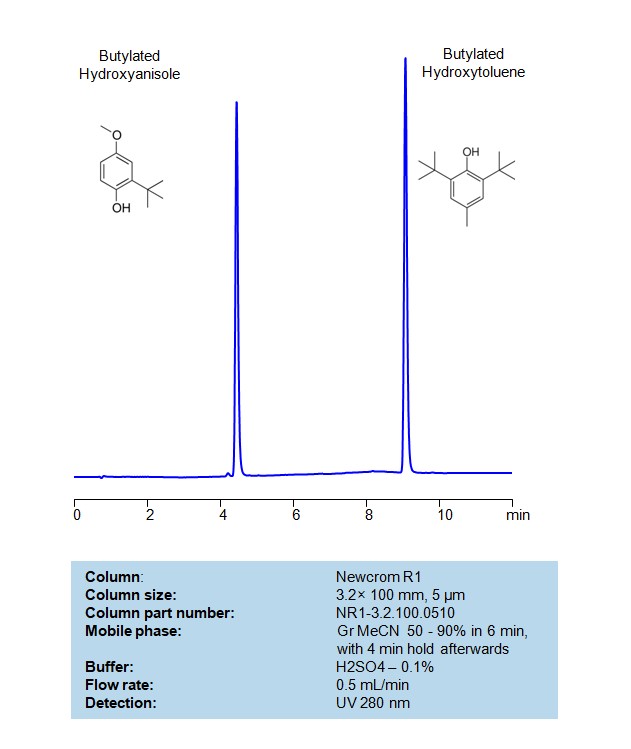HPLC Method for Analysis of Butylated hydroxytoluene, 3-tert-butyl-4-hydroxyanisole (BHA) on Newcrom R1 Column by SIELC Technologies
Separation type: Liquid Chromatography Reversed-phase

3-tert-butyl-4-hydroxyanisole (BHA) is a synthetic antioxidant commonly used as a food preservative. It is an aromatic compound with the chemical formula C11H16O2. BHA belongs to a class of compounds known as butylated hydroxyanisoles.
Function: BHA is used as an antioxidant to prevent the spoilage of fats and oils in various food products. It helps protect these substances from oxidative degradation, extending the shelf life of processed foods.
Chemical Structure: The compound has a molecular structure with a tert-butyl group (tert-butyl radical) attached to the oxygen atom of a hydroxyanisole group. The IUPAC name for BHA is 2-tert-butyl-4-methoxyphenol.
Usage: BHA is commonly used in a variety of food products, including snack foods, baked goods, cereals, and fats and oils. It is also used in certain cosmetic and pharmaceutical products.
Butylated Hydroxytoluene (BHT) is a synthetic antioxidant belonging to the class of compounds known as butylated hydroxytoluenes. Like BHA (butylated hydroxyanisole), BHT is commonly used as a food preservative to prevent the oxidation of fats and oils in various processed foods. It is also used in other products, including cosmetics, pharmaceuticals, and industrial applications.
Function: BHT acts as an antioxidant by inhibiting the oxidation of fats and oils. It helps prevent the development of off-flavors and odors in foods, extending their shelf life.
Usage: BHT is commonly used in a variety of food products, including snacks, cereals, baked goods, and processed meats. It is also used in some cosmetic and personal care products and in the packaging of certain products to prevent oxidation.
BHA and BHT can be retained, separated and analyzed on a reversed-phase Newcrom R1 column with a mobile phase consisting of water, Acetonitrile (MeCN), and sulfuric acid. This analytical method can be detected with high resolution and peak symmetry at a wavelength of 280 nm using UV detection
High Performance Liquid Chromatography (HPLC) Method for Analyses of Butylated hydroxytoluene, 3-tert-butyl-4-hydroxyanisole (BHA) on Newcrom R1 Column by SIELC Technologies
Condition
| Column | Newcrom R1, 3.2 x 100 mm, 5 µm, 100 A, dual ended |
| Mobile Phase | Gradient MeCN – 50 -90%, 6 min, 4 min hold |
| Buffer | H2SO4 – 0.1% |
| Flow Rate | 0.5 ml/min |
| Detection | UV 280 nm |
| Injection volume: | 1 µL |
| Sample | 1 mg/ml |
| Sample Diluent | MeCN/H2O – 50/50% |
Description
| Class of Compounds | butylated hydroxyanisoles (BHAs) |
| Analyzing Compounds | Butylated hydroxytoluene, 3-tert-butyl-4-hydroxyanisole (BHA) |
Application Column
Newcrom R1
Column Diameter: 3.2 mm
Column Length: 100 mm
Particle Size: 5 µm
Pore Size: 100 A
Column options: dual ended
Butylated hydroxytoluene





